by Susanna Ives
The following post was borrowed from my personal blog that detailed my recent trip to Wales and Bath.
My husband took the children to Stonehenge, leaving Mom and I to wander Bath. Actually “wander” is not an accurate term as it connotes something leisurely. We had exactly six hours to see the city before being carted away to London.
This was my second visit to Bath. The first time I visited was with my awesome cousin H. I had just gotten out of graduate school after a grueling quarter of non-stop, up-all-night work. For the two miserable years I spent in graduate school, I kept “Pride and Prejudice” in the VHS player, watching it over and over like a balm to my ailing brain. When I hit England all I wanted to see was Jane Austen things. Jane Austen. Jane Austen. Jane Austen. However, H was working on her Masters in history, specializing in Medieval England. So I didn’t get to see much Jane Austen, but a whole hell of a lot of really, really old England. I nearly froze my butt off at Sarem (my butt was significantly smaller then.). Nonetheless, H kept me from totally embarrassing myself in historic places (she can name all the British monarchs…it’s pretty impressive, not like the Danes where you got a 50/50 chance that it’s Frederick or Christian) In Bath, H and I stayed in rooms that required money to keep the radiator running and a coin operated bathtub that we shared with all the other tenants. Also, I don’t really like meatballs. Yet the night H and I arrived in England, blurry–eyed and hazy from the jet lag, I ordered spaghetti with meatballs. The very next day the Mad Cow panic hit.
Okay, I’m totally digressing...
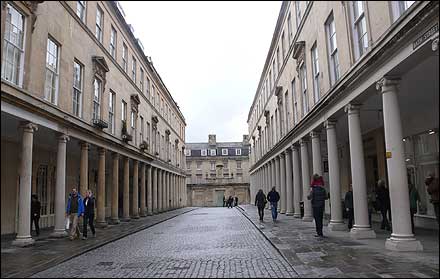
Bath
Bath was a happening resort town during Georgian Era or the period when the Georges were on the throne of England. For those who remember dates, that’s 1714-1830. The architecture has remained surprisingly unaltered through time and is an excellent example of the period. I’m lousy with architectural history, but from what I understand Georgian design is obsessed with the clean lines and mathematical precision of classicism. The understated style is sandwiched between the more bombastic Baroque and Victorian.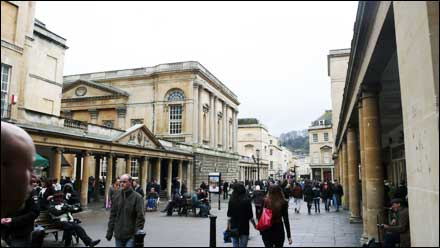
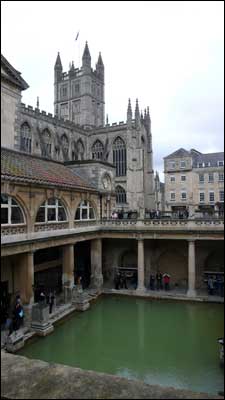
Aqueas Sulis
There are two stories explaining the origins of Bath. In the first, King Bladud created the springs through divination. He went on to build feathered wings for himself, but sadly died flying into the Temple of Appollo in New Troy. Bummer. In the second story, Bladud became afflicted with leprosy and left the court to become a swineherder. He and his pigs, also stricken with leprosy, found the springs and were cured. Bladud returned to court, became king, and fathered King Lear. Regardless, there was an early Celtic shrine erected at the springs dedicated to the goddess Sulis. Later the Romans would appear on the scene and build “Aqueas Sulis” proper, though they identified Sulis as the goddess Minerva.
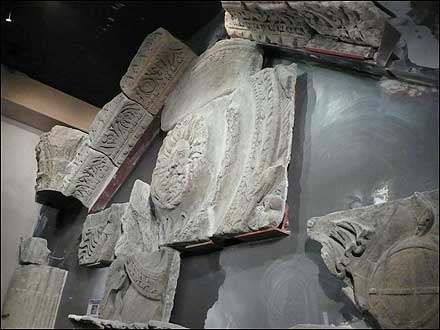
Ruins from the Roman Temple
After the Romans, things slide right into the dismal Middle Ages where everyone managed to forget that the earth was round and went around the sun, or how to make flush toilets, or build decent roads.
Nonetheless, rumor had it the springs had curative powers, and ailing people from all over England continued to come and swim or drink the waters. What you see today was built in the eighteenth century.
The museum takes you into the archeological diggings of the Roman Bath temple and chambers including the hot, cold, and warm baths. There a bunch of stone stuff to Minerva, but I’ve never “ohh-ed and ahh-ed” over Roman art. It’s the Roman drain still holding runoff from the springs that fascinates me or the stone piles that held up the floor to allow hot vapor to build up underneath. What happens when geeks travel…
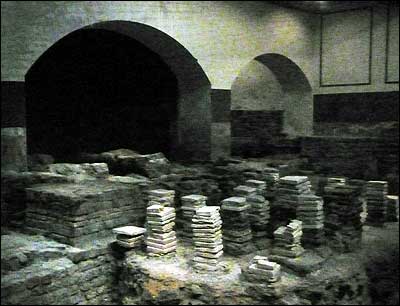
Heated Roman Floor
Here is a virtual tour of the Baths
We actually began the day at the Jane Austen Museum where we listened to a great lecture on Jane’s family, which I can hardly remember as I write. That short term just can't seem to make the haul to long term anymore. Must be mad cow kicking in.
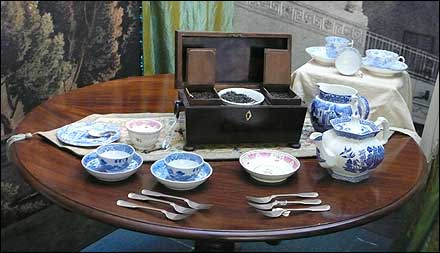
Tea Service
Here is what I remember from the lecture:
Jane had a love, but mostly hate relationship with Bath. She was a nasty critic of its society. Her family removed to the resort city from the country. Unfortunately, the Austen family overextended themselves and had to give up their first finer home in Bath. Over time, they slipped slowly down through the cracks of society until the final blow of Mr. Austen’s death, leaving the females in the family in financial straits. Jane’s brothers came to their rescue and set up the women on a country home. Unlike the Brontes, the male Austens were generally decent people.
Though several of her novels were set in Bath, Jane did not write much while living in the town. The novels that we read today were either written or rewritten from earlier novels at Jane’s home in the country.
Here is a neat sign explaining how people lived in Jane’s time based on their income level.
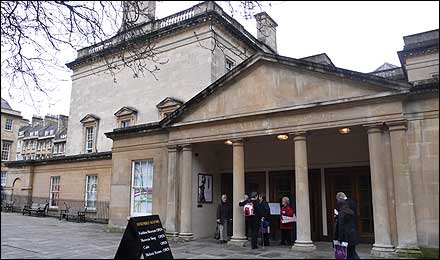
The Assembly Rooms
The Assembly rooms were bombed in WWII. What you see today is a careful restoration. Up until the Prince Regent built the Royal Pavilion in Brighton in the early nineteenth Century, Bath was the most popular resort town in England. People came in from nearby Bristol, London, and the countryside to rent a house for the season. All levels of society mingled in Bath, thanks to big-man-about-town Richard Beau Nash. He laid down “rules” of behavior for Bath, which excluded all sorts of lovely pursuits such as dueling with swords, cock-fighting, or bull-baiting.
Nash’s rules are pretty humorous, so I will include them.
I. That a visit of ceremony at coming to Bath, and another at going away, is all that is expected or desired by ladies of quality and fashion - except impertinents.
II. That ladies coming to the ball appoint a time for their footmen's coming to wait on them home, to prevent disturbances and inconveniences to themselves and others.
III. That gentlemen of fashion never appearing in a morning before the ladies in gowns and caps, shew breeding and respect.
IV. That no person take it ill that any one goes to another's play or breakfast, and not to theirís - except captious by nature.
V. That no gentleman give his tickets for the balls to any but gentlewomen - N.B. Unless he has none of his acquaintance.
VI. That gentlemen crowding before ladies at the ball, shew ill-manners; and that none do so for the future- except such as respect nobody but themselves.
VII. That no gentlemen of lady take it ill that another dances before them - except such as have no pretence to dance at all.
VIII. That the elder ladies and children be contented with a second bench at the ball, as being past or not come to perfection.
IX. That the younger ladies take notice how many eyes observe them - N.B. This does not extend to the Have-at-Alls.
X. That all whispers of lies and scandal be taken for their authors.
XI. That all repeaters of such lies and scandal be shunned by all company - except such as have been guilty of the same crime.
N.B. Several men of no character, old women and young ones of questioned reputation, are great authors of lies in the place, being of the sect of Levellers.
In the winter months or “season,” people bought subscriptions to attend activities at the Assembly Rooms. On Monday’s there was a Dress Ball which cost a guinea for three tickets. It started at six o’clock. For the first two hours, stately minuets were danced, followed by some get-down country dances lasting until nine. Then everyone went to Tea Room for refreshments of sweet meats, jellies, wine, biscuits, cold ham, turkey, tea with arrack and lemon. Concerts were held on Wednesday. Musical guests included Joseph Haydn and Franz Liszt. Cotillion balls or country dances occurred on Thursdays. Cards could be played every day. Gambling was an addiction in that period and lots of pounds were laid down on Whist, a precursor to Bridge and Spades, and Vingt-et-Une (blackjack).
Sadly, in the early nineteenth century, society followed the Prince to Brighton and the Assembly Rooms fell into decline, becoming a cinema in the 1920s.
I couldn’t get good pictures of the room because there were portable chairs stacked about. So I would suggest the Assemble Room virtual tour.
Housed beside the Assemble Rooms, is the tres cool Bath Costume Museum. However, if you want to see some awesome costumes, you gotta go to the Victoria and Albert museum in London.
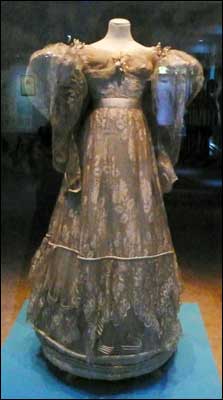
This dress is from approximately 1830 because of the slightly lowered waistline.
From the Assemble rooms, we hot-footed it over to No 1. Royal Crescent. Crescents are big thing in Georgian England.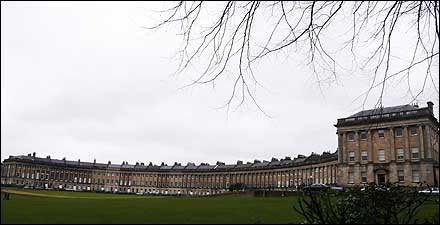
Royal Crescent
No. 1 Royal Crescent is a museum of the typical Bath home in the Georgian era. Unfortunately, the museum wouldn’t indulge my photo obsession, which prompts me to mention my other fixation: guidebooks. I feel like a set designer when I visit these homes. What did it look like, what did it feel like, how would one move in the space? I get nothing from the sterile environment of museums where artifacts are kept under glass. I want contextualization, silence, and time. Once my mother let me in a house that was about to be given to the Georgia Historical Society. The place hadn’t been altered since the turn of the century. It was like a playground to me, wandering through the rooms, like the quiet human observing the ghosts.
The Bath homes were row houses that extended up five or more stories from basement. Under the entrance walkway would be the coal vault, behind it an open area that led to the kitchen. On the iron fences above would be a rigged pulley or winch that allowed supplies to be lowered to the kitchens below. The basement level contained the kitchen rooms with a large fireplace and spit, servant’s table, and an additional vault for storing wine and beer. Some feet behind that vault wall was the cesspit that accepted the drainage from the outdoor privy running above it. Liquid matter in the cesspits was supposed to seep into the ground. Cesspits were emptied by the night soil men who came around early in the morning or by the poor servants who would have to haul the waste, bucket by bucket, through the house. They may have dumped the contents into the sewer opening in the front of the house which was technically illegal. These sewage passages were made of brick and did not have a constant flow of water to push the contents along.
The first floor (Americans add one floor) opened to a central hall flanked by parlors or a dining room. The dining room could be on first or second floor. In this house, the stairway zigzagged up the back wall of the house with another circular servant’s stairway on the side of the house. In other homes, the staircase emptied into the central hall, not a few feet from the front door.
Aside from the parlor downstairs, on the second floor there could be a withdrawing or drawing room, study, male or female parlor. Bedrooms made up the three floor and the children and servants stayed on the attic floor. Every room had a chimney and corresponding chimney pot belching coal smoke and soot into the sky.
Water as supplied to a lead cistern in the kitchen. It came to the house through narrow lead pipes which feed from larger pipes made of hollowed out elm trunks. Bath had a consistent supply of water because it tapped the natural springs in the area. Water companies were private. In London, where the water supply was not always constant, a house could have water supplied by multiple companies. Typically, water was serviced only to the ground floor. Inside the house, people could use a chamber pot or if they were lucky they had a water closet which was created either by a tank or pump forcing water up in a pipe leading from the cistern in the basement.
The entrance way would include a foot scrape, iron lamp bracket for holding the torches that the city required be burned at night during the winter months, a fire insurance plaque so the private firefighters knew to put out a fire at the home, and a snuffer for extinguishing torches.
Afterwards we strolled through the lovely parks and not so lovely parking lots until we reached the unassuming row house once belonging to famed astronomers, William Herschel and his sister Caroline Herschel. William Herschel is credited for using his telescopes to find Uranus, and the moons Titania and Oberon. Caroline is famous for finding several comets, a nebulae, and for putting up with her brother.
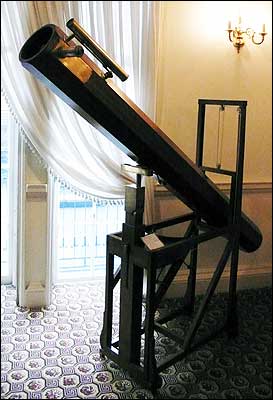
Replica of Herschel's Seven Foot Newtonian Reflecting Telescope. He used the original to find Uranus in 1781.
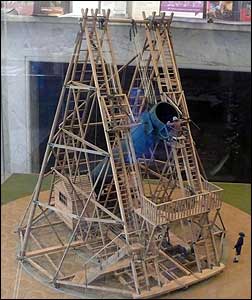
Model of Herschel's Forty Foot Telescope
William, born in Hannover, started his professional career as a composer. Unfortunately he wasn’t so well–received. In fact, he had to publish a public apology in Bristol newspaper concerning his horrific performance of “The Messiah.”
Poor pox scarred Caroline was left behind in Hannover to be a housekeeper to her family. She joined William when he came to Bath. He taught her English and gave her music lessons. Often she assumed the role of lead singer in his choral works. (Caroline probably had more promising in a musical career than her brother, but she declined the opportunities presented to her.) William considered astronomy a mere hobby. Unfortunately he couldn’t afford a nice, new shiny, telescope, so he decided to build one. And that’s when all hell broke loose. Building telescopes became his passion. Caroline writes, “It was my sorrow that I saw almost every room in the house turned into a workshop.” Keep in mind, William used horse poo-poo to make molds for his lens.
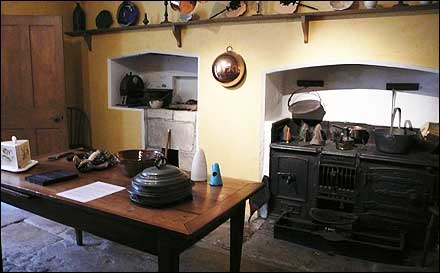
Herschel's Kitchen.
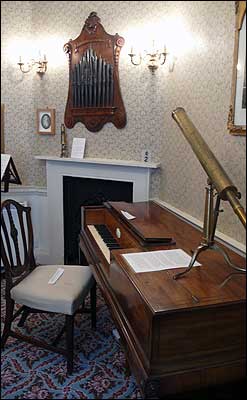
Music Room
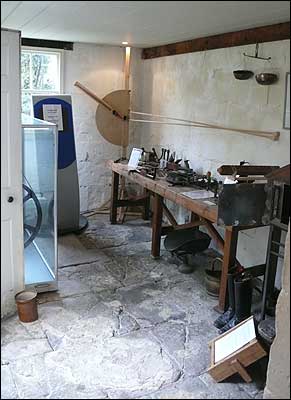
Herschel's Tiny Workroom at the very back of the house.
It was in this garden that in 1781 Hershel discovered Uranus.
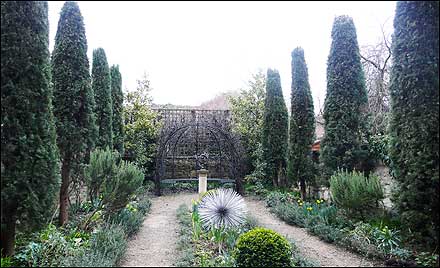
It was getting close to time to meet N and the children. Mom and I swung into the Sally Lunn house, reputedly the oldest house in Bath, circa 1482. It’s a restaurant, but in the basement is a tiny museum to Sally Lunn’s kitchen. Sally Lunn was a French Hugueno who came to Bath in 1680. She became famous for her bread buns.
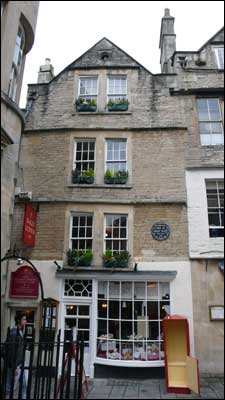
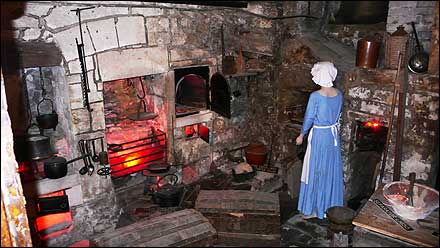
Sally Lunn Kitchen Museum
And then ten minutes in the Bath Abbey.
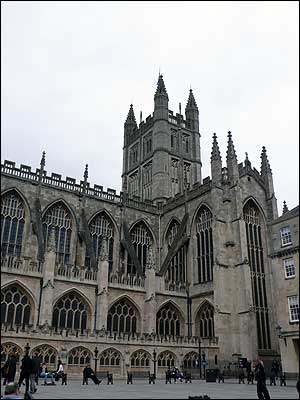
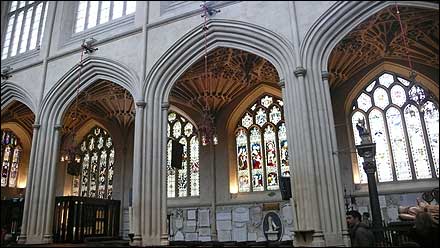
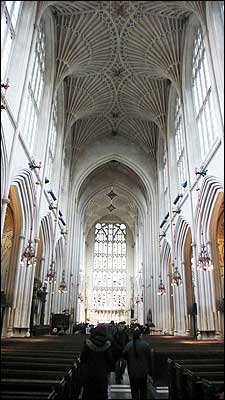
One minute at the chocolatier and onto London!

5 comments:
Thanks for the post! You took me back about 5 years when I visited Bath with my daughter who at the time was studying in Belgium. Your photos and story brought back wonderful memories!
Terrific information and photos. Enjoyed the tour.
Awesome post. I visited Bath one afternoon about 20 years ago. Somewhat touristy. Rainy at first but then nice and summery. The baths were fascinating, but I could not imagine thetaking the waters there! The Assembly rooms, eh. Probably so much more lively when fashionable ladies and gentlemen promenaded about. Did not stay as long as you and was pretty rushed. Would love to see it again with a better eye!
Interesting and great pictures.
Fascinating post!
I spent a year in England, living in Bristol, which is about 15 minutes by train from Bath. Whenever I could, I'd run down to Bath for the day to enjoy all the history and beauty.
Post a Comment